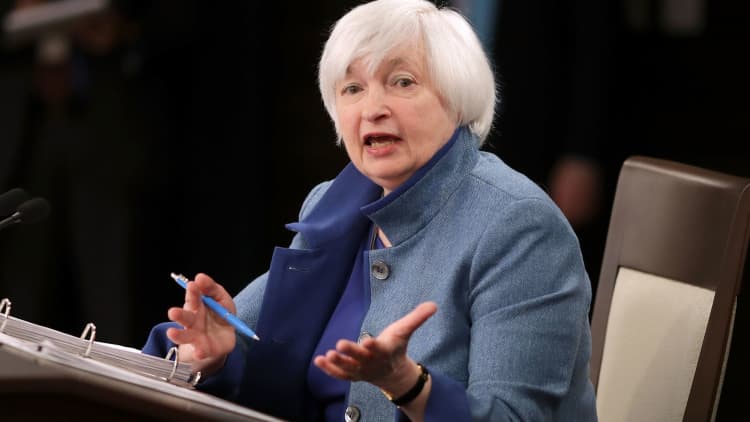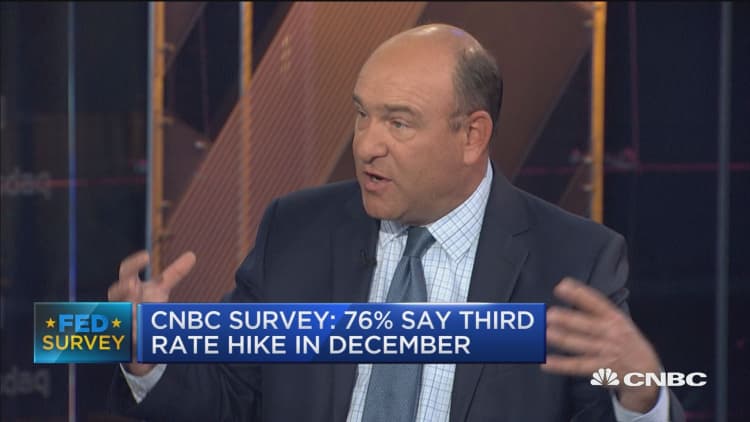
The Federal Reserve is on the cusp of reversing the most ambitious monetary stimulus program in world history amid questions over how much impact it really delivered.
There's little question that the program, known as quantitative easing or "money printing," boosted the stock market. The three iterations of QE between November 2008 and October 2014 each saw big boosts to the market, with a cumulative gain from beginning to end, including the various down periods between each leg, of about 140 percent.
The economic impacts, though, are less clear.
For most of the period, GDP struggled to gain more than 2 percent. Wealth disparity grew, income gains were hard to come by and the Fed continually came up short on its inflation goal.
With the U.S. central bank likely to announce this week that it will start unwinding its $4.5 trillion balance sheet of bonds and other securities, much of which accumulated in the QE era, the debate about the program's impact continues.
In fact, one of the Fed's own economists recently penned a report indicating that QE has come up short of its goals.
"Evaluating the effects of monetary policy is difficult, even in the case of conventional interest rate policy," St. Louis Fed economist Stephen D. Williamson wrote. "With respect to QE, there are good reasons to be skeptical that it works as advertised, and some economists have made a good case that QE is actually detrimental."
Williamson examined the aggressive easing policy in the U.S. and compared it with other parts of the world, in particular Japan, where QE originated. The program saw asset prices climb while inflation remained elusive. Central bankers believe a certain level of inflation is good for the economy as it signifies growth and usually coincides with rising income levels.
However, inflation has been scarce. The U.S. rate has remained stubbornly below 6 percent, despite an unemployment rate that has plunged from a 10 percent recession high to the current level of 4.4 percent, near a 16-year low.
Comparing to Canada, finding a difference
Williamson brought Canada into the comparison. In the time since the financial crisis when the Fed began QE, central banks in the U.S., Japan and Canada kept their benchmark rates near zero. Canada's balance sheet amounted to 5.1 percent of its GDP, while the Fed's balance sheet is now nearly 24 percent of GDP.
While Canada did not engage in QE, there was little difference in economic conditions between the three countries.
"[I]f QE were effective in stimulating aggregate economic activity, we should see a positive difference in economic performance in the U.S. relative to Canada since the financial crisis. ... There is little difference from 2007 to the fourth quarter of 2016 in real GDP performance in the two countries," Williamson wrote. "Indeed, relative to the first quarter of 2007, real GDP in Canada in the fourth quarter of 2016 was 2 percent higher than real GDP in the U.S., reflecting higher cumulative growth, in spite of supposedly less accommodative monetary policy.
"Thus, in these two natural experiments, there appears to be no evidence that QE works either to increase inflation, if we look at the Japanese case, or to increase real GDP, if we compare Canada with the U.S."
This isn't the first time Williamson has questioned QE's impacts.
In a paper he filed in 2015, the economist argued that "there is no work, to my knowledge, that establishes a link from QE to the ultimate goals of the Fed — inflation and real economic activity."
Back then, he urged the Fed to avoid confusion in the way it communicates its intentions to the market. For instance, he said guidance it had used that rates would remain low for an "extended period" was confusing and led to the low expectations for inflation.
During the run-up to the balance sheet reduction, the Fed has been comparatively explicit. Multiple officials have indicated the unwind will start soon. Market participants expect a firm announcement when this week's meeting concludes Wednesday, with the actual roll-off likely to start in October.
Under the announced plan, the Fed will allow a portion of the proceeds it receives each month to roll off. The monetary level will start at $10 billion then increase that much quarterly until it reaches $50 billion. Ultimately, economists expect the balance sheet to stabilize between $2 trillion and $3 trillion.
Fed Chair Janet Yellen, and most economists, expect the balance sheet operation to carry minimal market impact. However, history shows that central bank balance sheet reductions are often bumpy and lead to recessions.
"Clearly, there is a risk of a policy error which could trigger a sell-off in global financial markets,
but this week's confirmation that the Fed will begin reducing its balance sheet should pass off smoothly," Andrew Kenningham, chief global economist at Capital Economics, said in a note.
WATCH: Fed Survey: 76% expect third rate hike in December



